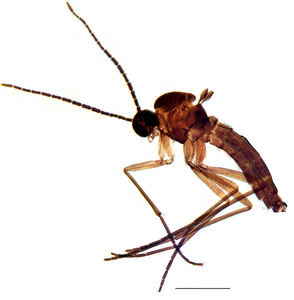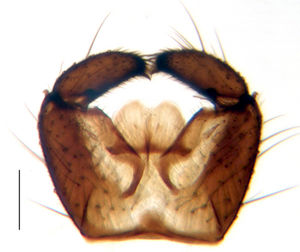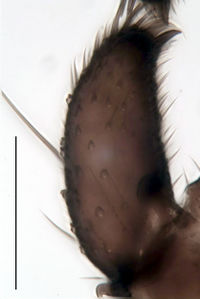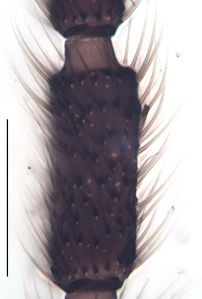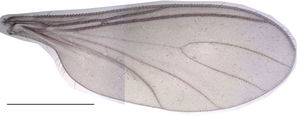Trichosiopsis perturbata
Ordo: Diptera
Familia: Sciaridae
Genus: Trichosiopsis
Name
Trichosiopsis perturbata Rudzinski, 2005 – Wikispecies link – ZooBank link
- Leptosciarella (Leptosciarella) perturbata Rudzinski, 2005[1]: 266-267, fig. 51, 52
Type material
Holotype: ♂, in NCHU, 22.11-10.12.1992, Malaise trap, leg. Lin & Yang, TAI 39
Type locality
Taiwan, Nantou County, NE Puli, Road Nr. 14, Meifeng Experim. Farm, ca. 24°06'N/ 121°10'E, 2100m
Papatype
Taiwan: 1 ♂, same data as holotype TAI 40 (in ZSMC)
Description (male)
Head. Eye bridge 4 rows of facets. LW-index of 4th antennal flagellar segment 2.36–2.6; neck 0.34–0.44 of segment width; Transition of basal part to neck pronounced. Colour of neck unicolour. Antennal hairs shorter than segment width; sparse; salient. Palps darkened; normal; palpomeres 3. First palpomere of normal shape; with 3–5 bristles; with only some sparse sensillae. Second palpomere shortly oval. Third palpomere as long as first segment. Thorax. Colour reddish. Notum unicolour. Thoracic setae normal; dark. Mesonotum with some weaker central bristles. Posterior pronotum setose. Postpronotal setae 1–2; strong. Mesothoracic sclerites bare. Legs. Colour yellow. Hind coxae of same colour as femora. Hairs on fore coxae black, or darkened. Front tibia apically with a patch of setae. Front tibial organ dark. Front tibial organ not bordered. Tibial setae on hind legs weak, inconspicuous, or normal, shorter than tibial width. Tibial spurs of equal length. Claws untoothed. Wings. Wings slightly darkened; of normal shape. Wing membrane without macrotrichia, or partially with macrotrichia. Wing venation weak, with faint m-base. M-fork of normal shape. R1 inserting at or slightly before base of m-fork; posterior veins with macrotrichia; stM mainly with macrotrichia; cuA1 and cuA2 mainly with macrotrichia; bM bare; r-m mostly setose; st-Cu:bM 1.9–2.1; r1:r 1–1.29; C:w 0.63–0.73. Halteres dark; of normal length. Abdomen. Abdominal setae strong and dense; dorsally dark; ventrally dark. Hypopygium concolour with abdomen; 0.6–0.72 × longer than wide. Base of gonocoxites with normal, weak hairs; gonocoxites forming an inverse V; inner margin of gonocoxites normally U-shaped; inner membrane of hypopygium scarcely setose; elongated setae on valves of hypopygium absent. Gonostylus elongate; 2.4–2.7 × longer than wide; Inner margin straight; apex tapered, or equally rounded. Apical tooth present; 3–3.3 × longer than broad; strong. Awl-like setae long, or normal; on inner side of gonostyles apically present. Megasetae on inner part of gonostylus absent. Whiplash-hair absent. Tegmen 0.6–0.72 × longer than broad; equally rounded; normal; Central process absent. Length of aedeagus/hypopygium 15–24 %; Aeadeagal apical structure absent. Measurements. Body size 3.3–3.9 mm. Hind tibia 1.48–1.69 mm. Wing length 3.1–3.7 mm.
Diagnosis
Trichosiopsis perturbata is striking by the bright reddish colour of the body. Contrary to most other species of the genus the hairs on the antennae are very strong and bristle-like as it is only known in Protosciarella virgatoalata.
Discussion
Rudzinski (2005[1]: 267) compared the species with Trichosiopsis rotunda because of the elongated dorsal awl-like setae. This character may also indicate a relationship to the genus Leptospina. The presence of apical macrotrichia on the wing membrane might even show a tendency towards Hirtipennia (Rudzinski, 2005[1]: 268). Thus nearly all formerly included subgenera of Trichosiopsis are being discussed for the placement of this species. This uncertainty shows up, that the worldwide variability and the phylogenetic arrangement of the species and of the basal subfamily Sciarinae is still very poorly known.
Etymology
lat. perturbare = to disturbe
Distribution
Taiwan[1].
Images
|
